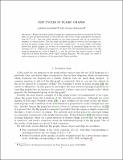Flip cycles in plabic graphs
Author(s)
Balitskiy, Alexey; Wellman, Julian
Download29_2020_544_ReferencePDF.pdf (1.625Mb)
Publisher Policy
Publisher Policy
Article is made available in accordance with the publisher's policy and may be subject to US copyright law. Please refer to the publisher's site for terms of use.
Terms of use
Metadata
Show full item recordAbstract
Abstract
Planar bicolored (plabic) graphs are combinatorial objects introduced by Postnikov to give parameterizations of the positroid cells of the totally nonnegative Grassmannian $$\text {Gr}^{\ge 0}(n,k)$$Gr≥0(n,k). Any two plabic graphs for the same positroid cell can be related by a sequence of certain moves. The flip graph has plabic graphs as vertices and has edges connecting the plabic graphs which are related by a single move. A recent result of Galashin shows that plabic graphs can be seen as cross-sections of zonotopal tilings for the cyclic zonotope Z(n, 3). Taking this perspective, we show that the fundamental group of the flip graph is generated by cycles of length 4, 5, and 10, and use this result to prove a related conjecture of Dylan Thurston about triple crossing diagrams. We also apply our result to make progress on an instance of the generalized Baues problem.
Date issued
2020-02-17Department
Massachusetts Institute of Technology. Department of MathematicsPublisher
Springer International Publishing
Citation
Selecta Mathematica. 2020 Feb 17;26(1):15
Version: Author's final manuscript